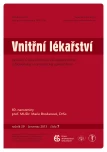Hepatic involvement in patients with non‑Hodgkin’s lymphoma
Authors:
M. Trněný 1; J. Šálková 1; J. Dlouhá 1; J. Stříteský 2
Authors‘ workplace:
I. interní klinika 1. lékařské fakulty UK a VFN Praha, přednosta prof. MU Dr. Marek Trněný, CSc.
1; Ústav patologie 1. lékařské fakulty UK a VFN Praha, přednosta doc. MU Dr. Pavel Dundr, Ph. D.
2
Published in:
Vnitř Lék 2013; 59(7): 606-611
Category:
Overview
Non‑ Hodgkin’s lymphoma (NHL) represent the most frequent hematological malignancy with frequent extranodal involvement. We have identified 79 pts (4.6%) out of 1,712 patients with NHL, who were diagnosed in our center between 1999–2010. Five cases were primary extranodal lymphomas and we have observed one primary hepatic lymphoma (0.015%). The most frequent (61.3%) NHL subtype in our cohort was diffuse large B‑ cell lymphoma. B‑ NHL formed 92.4% of all lymphomas. We have observed high number of HBsAg positive patients (10%). The whole group have poor prognostic features with high number of patients (85%) with intermediate‑ high and high risk according to international prognostic index. The patients were treated with chemotherapy in 95%, B‑ NHL patients recieved immunochemotherapy with rituximab in 77%. The median progression free survival, resp. overall survival 4.6, resp. 8.4 years in the whole group and 1.4, resp. 8.4 years in diffuse large B‑ cell lymphoma were observed with median follow-up 4.5 years. The outcome of T‑ NHL patients was significantly worse with overall survival median 1.2 vs 8.4 years (p < 0.033). The patients with B‑ NHL treated by immunochemoterapy with rituximab had significant death risk reduction (HR 0.44, p = 0.03) compared to the patients treated with chemotherapy.
Key words:
lymphoma – non‑Hodgkin’s lymphoma – hepatic impairment – extranodal impairment – immunochemotherapy – rituximab
Sources
1. Swerdlow SH et al. WHO classification of tumours of haematopoietic and lymphoid tissues. Lyon: IARC Press 2008.
2. Armitage JO, Weisenburger DD. New approach to classifying non‑Hodgkin’s lymphomas: clinical features of the major histologic subtypes. Non‑ Hodgkin’s Lymphoma Classification Project. J Clin Oncol 1998; 16: 2780– 2795.
3. Trneny M, Vášová I, Pytlík R et al. Distribuce podtypů non‑hodgkinského lymfomu v České republice a jejich přežití. Klin Onkol 2007; 20: 341– 348.
4. Gottlieb JA, Gutterman JU, McCredie KB et al. Chemotherapy of malignant lymphoma with adriamycin. Cancer Res 1973; 33: 3024– 3028.
5. McLaughlin P, Grillo‑ López AJ, Link BK et al. Rituximab chimeric anti‑CD20 monoclonal antibody therapy for relapsed indolent lymphoma: half of patients respond to a four‑dose treatment program. J Clin Oncol 1998; 16: 2825– 2833.
6. Cheson BD, Pfistner B, Juweid ME et al. Revised response criteria for malignant lymphoma. J Clin Oncol 2007; 25: 579– 586.
7. The Non‑ Hodgkin’s Lymphoma Classification Project. A clinical evaluation of the International Lymphoma Study Group classification of non‑Hodgkin’s lymphoma. Blood 1997; 89: 3909– 3918.
8. The International Non‑ Hodgkin’s Lymphoma Prognostic Factors Project. A predictive model for aggressive non‑Hodgkin’s lymphoma. N Engl J Med 1993; 329: 987– 994.
9. Bach AG, Behrmann C, Holzhausen HJ et al. Prevalence and imaging of hepatic involvement in malignant lymphoproliferative disease. Clin Imaging 2012; 36: 539– 546.
10. Civardi G, Vallisa D, Berte R et al. Focal liver lesions in non‑Hodgkin’s lymphoma: investigation of their prevalence, clinical significance and the role of Hepatitis C virus infection. Eur J Cancer 2002; 38: 2382– 2387.
11. Baumhoer D, Tzankov A, Dimhofer S et al. Patterns of liver infiltration in lymphoproliferative disease. Histopathology 2008; 53: 81– 90.
12. Takahashi H, Tomita N, Yokoyama M et al. Prognostic impact of extranodal involvement in diffuse large B‑ cell lymphoma in the rituximab era. Cancer 2012; 118: 4166– 4172.
13. Castellani R, Bonadonna G, Spinelli P et al.Sequential pathologic staging of untreated non‑Hodgkin’s lymphomas by laparoscopy and laparotomy combined with marrow biopsy. Cancer 1977; 40: 2322– 2328.
14. Noronha V, Shafi NQ, Obando JA et al. Primary non‑Hodgkin’s lymphoma of the liver. Crit Rev Oncol Hematol 2005; 53: 199– 207.
15. Viswanatha DS, Dogan A. Hepatitis C virus and lymphoma. J Clin Pathol 2007; 60: 1378– 1383.
16. Maloney DG, Liles TM, Czerwinski DK et al.Phase I clinical trial using escalating single‑dose infusion of chimeric anti‑CD20 monoclonal antibody (IDEC‑ C2B8) in patients with recurrent B‑ cell lymphoma. Blood 1994; 84: 2457– 2466.
17. Coiffier B, Lepage E, Briere J et al. CHOP chemotherapy plus rituximab compared with CHOP alone in elderly patients with diffuse large‑ B‑ cell lymphoma. N Engl J Med 2002; 346: 235– 242.
18. Marcus R, Imrie K, Belch A et al. CVP chemotherapy plus rituximab compared with CVP as first‑line treatment for advanced follicular lymphoma. Blood 2005; 105: 1417– 1423.
19. Salles G, Seymour JF, Offner F et al. Rituximab maintenance for 2 years in patients with high tumour burden follicular lymphoma responding to rituximab plus chemotherapy (PRIMA): a phase 3, randomised controlled trial. Lancet 2011; 377: 42– 51.
20. Kluin‑Nelemans HC, Hoster E, Hermine O et al. Treatment of older patients with mantle‑ cell lymphoma. N Engl J Med 2012; 367: 520– 531.
21. Trneny M, Pytlik R, Belada D et al. Treatment of diffuse large B‑ Cell lymphoma with rituximab, intensive induction and high‑dose consolidation: the final analysis of the Czech Lymphoma Study Group (CLSG) R‑ MegaCHOP‑ ESHAP‑ BEAM (R‑ MEB) trial. Blood 2007; 110: 14A.
22. Ferreri AJ, Govi S, Pileri SA. Hepatosplenic gamma‑ delta T‑ cell lymphoma. Crit Rev Oncol Hematol 2012; 83: 283– 292.
Labels
Diabetology Endocrinology Internal medicineArticle was published in
Internal Medicine

2013 Issue 7
Most read in this issue
- Relationship of bilirubin to diseases caused by increased oxidative stress
- Cystic tumors of the pancreas – our experience with diagnostics
- Acute pancreatitis – new developments in treatment
- Liver disorders in diabetic patients
